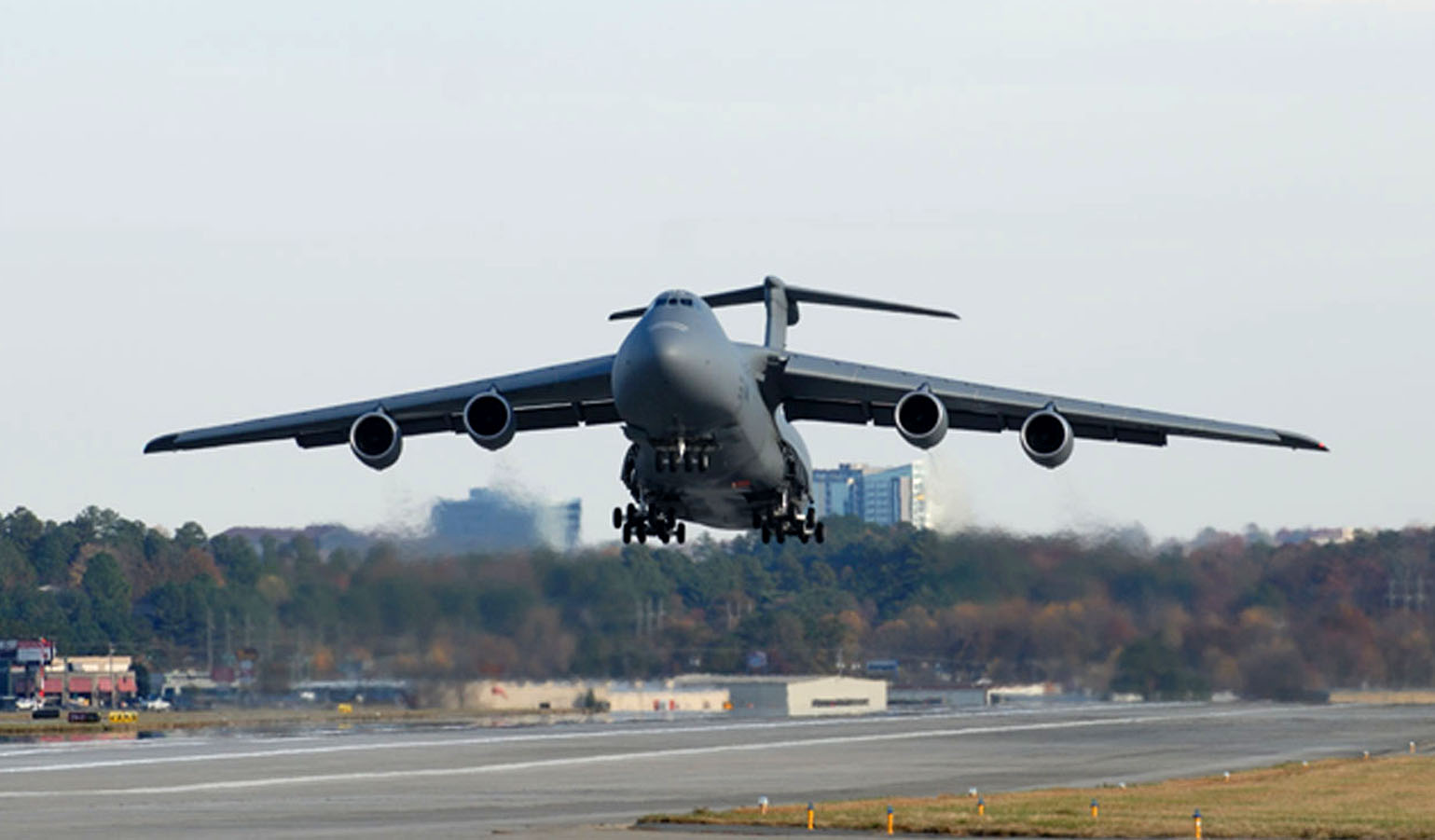Just from its Air Force fact sheet it states that it “is one of the largest aircraft in the world and the largest airlifter in the Air Force inventory.” Regardless of its size, the biggest difference the C-5 Galaxy makes is in supporting global airlift operations.
“The gigantic C-5 Galaxy, with its tremendous payload capability, provides the Air Mobility Command airlift in support of United States national defense,” the fact sheet states. “The C-5 can carry fully equipped combat-ready military units to any point in the world on short notice and then provide field support required to help sustain the fighting force.”
C-5 facts
By its sheer size, the C-5 is immense. General characteristics show it has a wingspan of 222.9 feet, is 247.1 feet long, and stands 65.1 feet high. To move the C-5, its four General Electric TF-39 engines generate 43,000 pounds of thrust each which can carry the plane to a maximum speed of 518 miles per hour.
The plane comes in three variants – the C-5A, C-5B, and the latest version – the C-5M Super Galaxy. Lockheed-Georgia Co. delivered the first operational C-5 to the 437th Airlift Wing, at then-Charleston Air Force Base, S.C., (now Joint Base Charleston) in June l970. In March 1989, the last of 50 C-5B aircraft was added to the 76 C-5As in the Air Force’s airlift force structure.
The C-5B includes all C-5A improvements as well as more than 100 additional system modifications to improve reliability and maintainability. In 1998, the C-5 Avionics Modernization Program began and includes “upgrading avionics to communications, navigation, surveillance and air traffic management compliance, improving navigation, communication, and safety equipment, and installing a new autopilot system.”
Additionally, another part of the C-5 modernization plan is a comprehensive re-engining and reliability program. The centerpiece of this program is the General Electric CF6-80C2 commercial engine which “delivers a 22 percent increase in thrust to the C-5, a 30 percent shorter take-off roll, has a 58 percent faster climb rate and will allow significantly more cargo to be carried over longer distances.” With the new engine and upgrades, the C-5 was designated the C-5M Super Galaxy.
Hauling the ‘big stuff’
With aerial refueling, a C-5 can carry more than 270,000 pounds of cargo to practically anywhere in the world. Because of that ability, Airmen who fly and maintain them have taken on some big loads.
For example, in August 2010, a C-5M and crew from Dover Air Force Base, Del., flew the $1 billion-plus Alpha Magnetic Spectrometer from the European Organization for Nuclear Research in Switzerland to Kennedy Space Center, Fla. Nobel Laureate, Dr. Samuel Ting, said in an AMC news report the particle detector was so large that without the C-5 to haul it, it would have required a certain level of disassembly.
“I’m very grateful the U.S. Air Force came to help us,” Dr. Ting said about the use of the C-5.
As another example, from February to March 2011, two C-5Bs and two C-5Ms and crew and maintenance Airmen from Dover AFB were part of a U.S. Transportation Command “multi-modal” airlift effort in Western Europe.
That effort, according to officials at Scott AFB’s Tanker Airlift Control Center, or TACC, included airlifting approximately 3,300 tons of cargo – mainly Army helicopters such as the CH-47, UH-60, OH-58, and AH-60. Overall, TACC officials said, the C-5s moved more than 170 helicopters in the operation.
Furthermore, a C-5 and crew made a delivery to Yokota Air Base, Japan, supporting Operation Tomodachi in Japan on April 3. They transported the Chemical-Biological Incident Response Force – a 155-person team comprised of Marines from Naval Support Facility, Indian Head, Md. The Marines supported Operation Tomodachi “by providing a rapid response capability, and if requested, can assist and advise Japanese authorities,” one Air Force report shows.
Continuing support wherever needed
C-5s are located only at a few bases. They are currently operate from Dover AFB; Travis AFB, Calif.; Lackland AFB, Texas; Stewart Air National Guard Base, N.Y.; Martinsburg ANGB, W.V.; Memphis ANGB, Tenn.; Wright-Patterson AFB, Ohio; and Westover Air Reserve Base, Mass.
Wherever they are home-based, or deployed to places such as Western Europe or Southwest Asia, officials say they are a crucial piece to the global airlift puzzle.
“We’ve got C-5s coming in here and we’re making sure they’re getting out of here in tip-top shape,” said Senior Airman Douglas Osman, an engine specialist with the 521st Air Mobility Operations Group at Al Asad Air Base, Iraq, in a recent Air Force news report.
Airman Osman may have also summed it up best about the entire C-5 community when he said they (his group and C-5s) are “getting cargo to people who need it.”










